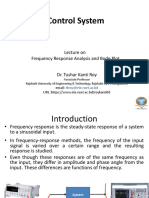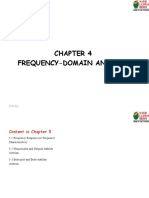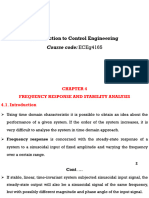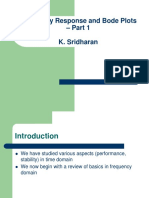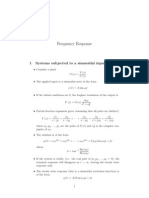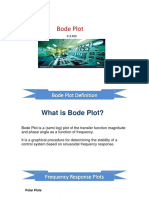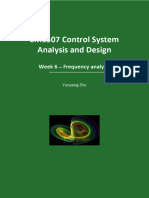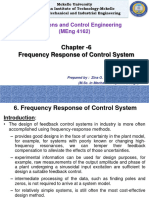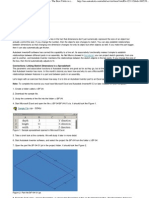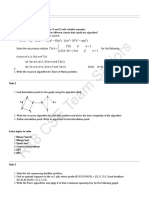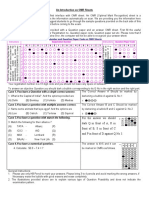MECE-6397:
FEEDBACK CONTROL SYSTEMS
Frequency Response
Introduction
�Viewpoints of analyzing control
system behavior
Routh-Hurwitz
(s = + j )
Root
locus
(s = + j )
Bode
diagram
(plots)
(s = j )
Nyquist
plots
(s = j )
Nicols
plots
(s = j )
Time
domain
�Frequency Response
�Frequency Response
r(t) =A sin !t + B cos !t
p
= A2 + B 2 cos[!t + tan
(B/A)]
As + B!
C(s) = 2
G(s)
s + !2
Steady
State
Response
�Frequency Response
Mo \
= (Mi \ i )(MG \
MG \
= G(j!)
G)
�MECE-6397:
FEEDBACK CONTROL SYSTEMS
Frequency Response
Bode Plot
�Advantages of Bode plot
-
-
-
-
Dynamic compensator design can be entirely
in Bode plots
Bode plots can be determined experimentally
Bode plots in series simply add, which is
quite simple for design purpose
The use of log-scale permits a much wider
range of frequencies to be displayed in a
single plot than is possible with linear scale
�Logarithmic
coordinate
Decade
:
dec = log10
2
1
Octave
:
oct = log 2
2
1
dB
3 4
10
20
100
�Y (s)
K(s + z1 )(s + z2 )!
=
R(s) (s + p1 )(s + p2 )(s 2 + as + b)!
Case
I
:
K
GH (dB )
Magnitude:
0.1
10
K dB = 20 log K (dB)
GH
Phase:
"$
0o , K > 0
K = #
o
$% 180 , K < 0
1800
90 0
�1
sp
Case
II
:
Magnitude:
1
( j ) p
0.1
dB
1
( j ) p
p=2
p =1
= 20 p log (dB )
10
GH
Phase:
GH (dB )
= (90 o ) p
90 0
90
1800
p =1
p=2
10
�sp
Case
III
:
GH (dB )
Magnitude:
( j ) p
dB
p =1
= 20 p log (dB )
0.1
GH
Phase:
180
p
p=2
( j ) = (90 ) p
90
10
p=2
p =1
90 0
1800
11
�Case
IV
:
a
1
or ( s +1)1
(s + a)
a
a =1
Magnitude:
GH (dB )
1
)
= 20 log 1+ ( )2
a dB
a
= 10 log[1+ ( )2 ]
a
(1+ j
0.1
0 M = 10 log1 = 0dB
a
>> a 1+ j M 20 log dB GH
a a
a
1800
M = [20 log 20 log a]dB
10
<< a
= a 450
90 0
= a M = 10 log 2 = 3.01dB
Phase:
0
1
1 / (1+ j ) = 0 tan
a
a
90 0
1800
<< a 0 GH tan 1 0 = 0 o
a
>> a GH tan 1 = 90 o
a
12
�(s + a)
1
or ( s +1)
a
a
Case
V
:
a =1
Magnitude:
GH (dB )
(1 + j
)
dB
= 20 log 1 + ( ) 2
a
= 10 log[1 + ( ) 2 ]
a
0.1
0 M = 10 log1 = 0dB
a
>> a 1+ j M 20 log dB GH
a a
a
1800
M = [20 log 20 log a]dB
10
<< a
= a M = 10 log 2 = 3.01dB
= a 450
90 0
Phase:
(1 + j
) = tan
90 0
1800
0 GH tan 1 0 = 0 o
a
>> a GH tan 1 = 90 o
a
<< a
13
�14
� n2
T (s) = 2
s + 2 n s + n2
Case
VI
:
T ( j ) =
T ( j ) =
"
$
$
$
$$
T ( j ) = #
$
$
$
$
$%
n2
2
( n 2 ) + 2 j n
1
(1 ( ) ) + j 2
n
n
0,
<< 1
n
20 log(2 ),
=1
n
40 log( ),
>> 1
n
n
T ( j ) = tan 1
2 n
2
( n 2 )
n
1
T ( j ) = tan
2
1 ( )
n
2
#
0
0
,
%%
T ( j ) = $ 90 0 ,
%
o
180
,
%&
<< 1
n
=1
n
>> 1
n
15
� = n
16
�Bode plots
So
G( jw) = | G( jw) | G( jw)
Magnitude
Phase Angle
Magnitude in dB = 20 log10 | G ( jw) |
Hence Bode Plot consists of two plots
Magnitude ( 20 log10 | G ( jw) | dB) Vs frequency plot (w)
Phase angle ( G ( jw) )Vs frequency plot (w)
�Bode plots
G( jw) =
K 1(1+ jwT1 )(1+ jwT2 )...(1+ jwTm )
2+
')
!
$
)
jw
jw
N
( jw) (1+ jwTa )(1+ jwTb ) ... (1+ jwTn ) (1+ 2 + # & ,
wn " wn % ))*
Magnitude in dB
20 log10 | G( jw) |= 20 log10 | K | + 20 log10 | 1 + jwT1 | +20 log10 | 1 + jwT2 | ... + 20 log10 |1+ jwTm |
20 log10 |1+ jwTa | 20 log10 |1+ jwTb |... 20 log10 |1+ jwTm | etc
Phase Angle
G( jw) = ( K ) + (1 + jwT1 ) + (1 + jwT2 )... + (1 + jwTn )
(1 + jwTa ) (1 + jwTb )... (1 + jwTm ) etc
= tan 1 ( jwT1 ) + tan 1 ( jwT2 )... + tan 1 ( jwTm )
90 N tan 1 ( jwTa ) tan 1 ( jwTb )... tan 1 ( jwTn ) etc
�Bode plot procedure
Steps to draw Bode Plot
1. Convert the TF in following standard form & put s=jw
G( jw) =
K 1(1+ jwT1 )(1+ jwT2 )...(1+ jwTm )
2+
')
!
$
)
jw
jw
( jw) N (1+ jwTa )(1+ jwTb ) ... (1+ jwTn ) (1+ 2 + # & ,
wn " wn % ))*
2. Find out corner frequencies by using
1 1 1
1 1 1
,
,
...
,
,
Rad / sec
T1 T2 T3 Ta Tb Tc
etc
3. Draw the magnitude plot. The slope will change at each
corner frequency by +20dB/dec for zero and -20dB/dec for
pole.
v For complex conjugate zero and pole the slope will change
by 40dB / dec
�Ex. Bode plot
Solution:
1000
G( s) =
(1 + 0.1s)(1 + 0.001s)
1. Convert the TF in following standard form & put s=jw
1000
G ( jw) =
(1 + 0.1 jw)(1 + 0.001 jw)
2. Find out corner frequencies
1
= 10
0.1
1
= 1000
0.001
So corner frequencies are 10, 1000 rad/sec
�Ex.- Contd
Magnitude Plot
�Ex.
50(s + 2)
G(s) =
s(s +10)
1
1
G(s) = 10( )(0.5s +1)(
)
s
0.1s +1
�Ex.
5(1 + j0.1!)
G(j!) =
j!(1 + j0.5!) 1 + j0.6(!/50) + (j!/50)2
Magnitude
asymptotes
of
poles
and
zeros
used
in
the
example.
�Ex.- Contd
Magnitude
characterisSc.
�MECE-6397:
FEEDBACK CONTROL SYSTEMS
Frequency Response
Stability Margin
�Bode plot GM & PM
Gain Margin: It is the amount of gain in dB that can be
added to the system before the system become
unstable
GM in dB = 20log10(1/|G(jw|) = -20log10|G(jw|
Gain cross-over frequency: Frequency where magnitude plot
intersect the 0dB line (x-axis) denoted by wg
Phase Margin: It is the amount of phase lag in degree
that can be added to the system before the system
become unstable
PM in degree = 1800+angle[G(jw)]
Phase cross-over frequency: Frequency where phase plot
intersect the 1800 dB line (x-axis) denoted by wp
Less PM => More oscillating system
�GM and PM via Bode Plot
The
frequency
at
which
the
phase
equals
180
degrees
is
called
the
phase
crossover
frequency
GM
The frequency at which
the magnitude equals 1
is called the gain
crossover frequency
M
GM
gain crossover frequency
phase
crossover
frequency
�Bode plot GM & PM
�Bode plot and stability
1. Stable
If wg<wp => GM & PM are >0
2. Unstable
If wg>wp => GM & PM are <0
3. Marginally stable
If wg=wp => GM & PM are zero
�Example
Find Bode Plot and evaluate a value of K
that makes the system stable
The system has a unity feedback
with an open-loop transfer function
K
G(s) =
( s + 2)(s + 4)(s + 5)
First, lets find Bode Plot of G(s) by assuming
that K=40 (the value at which magnitude plot
starts from 0 dB)
�At phase = -180, = 7 rad/sec, magnitude = -20 dB
� GM>0,
system
is
stable!!!
Can
increase gain
up 20
dB
without
causing
instability
(20dB
=
10)
Start
from
K
=
40
with K
<
400,
system
is
stable
�Closed-loop transient and closedloop frequency responses
2nd system
n2
C (s)
= T (s) = 2
R( s )
s + 2 n s + n2
�Damping ratio and closed-loop frequency
response
Mp =
1
2 1 2
p = n 1 2 2
Magnitude Plot of closed-loop system
�Response speed and closed-loop frequency
response
BW = n (1 2 2 ) + 4 4 4 2 + 2
BW
4
=
Ts
BW =
(1 2 2 ) + 4 4 4 2 + 2
Tp 1 2
(1 2 2 ) + 4 4 4 2 + 2
BW = frequency at which magnitude is 3dB down
from value at dc (0 rad/sec), or M =
1
2
�Relationship between
damping ratio and phase margin
of open-loop frequency response
Phase margin of open-loop frequency response
Can be written in terms of damping ratio as following
M = tan
2
2 2 + 1 + 4 4
�Example
Open-loop system with a unity feedback has a bode plot
below, approximate settling time and peak time
BW
=
3.7
PM=35
�M = tan
Solve for PM = 35
Ts =
2
2 2 + 1 + 4 4
= 0.32
(1 2 2 ) + 4 4 4 2 + 2
BW
= 5. 5
Tp =
BW 1 2
= 1.43
(1 2 2 ) + 4 4 4 2 + 2
�MECE-6397:
FEEDBACK CONTROL SYSTEMS
Frequency Response
Nyquist Stability Criterion
Introduction
�Knowledge Before
Studying Nyquist Criterion
High Gain
(K)
Stability
Margins
Harry Nyquist: Bell Telephone Laboratories (1932)
�Knowledge Before
Studying Nyquist Criterion
Open-loop
G( s)
T ( s) =
1 + G( s) H ( s)
CharacterisSc
EquaSon
unstable if there is any pole on RHP (right half plane)
N G ( s)
G (s) =
DG ( s )
N H ( s)
H ( s) =
DH ( s)
�N G ( s)
G (s) =
DG ( s )
N H ( s)
H ( s) =
DH ( s)
Open-loop system:
N G ( s) N H ( s)
G(s) H (s) =
DG ( s ) DH ( s )
Characteristic equation:
N G N H DG DH + N G N H
1 + G( s) H ( s) = 1 +
=
DG DH
DG DH
poles of G(s)H(s) and 1+G(s)H(s) are the same
Closed-loop system:
N G ( s) DH ( s)
G( s)
T ( s) =
=
1 + G ( s) H ( s) DG ( s) DH ( s) + N G ( s) N H ( s)
zero of 1+G(s)H(s) is pole of T(s)
�(s 1)(s 2)
G(s)H (s) =
(s 3)(s 4)
G ( s) H ( s)
1 + G( s) H ( s)
G( s)
1 + G( s) H ( s)
Zero
Zero a,b
Zero ?,?
Poles
Poles
Poles a,b
To
know
stability,
we
have
to
know
a
and
b
�MECE-6397:
FEEDBACK CONTROL SYSTEMS
Frequency Response
Nyquist Stability Criterion
Introduction
�Stability from Nyquist plot
From
a
Nyquist
plot,
we
can
tell
a
number
of
closed-loop
poles
on
the
right
half
plane.
If
there
is
any
closed-loop
pole
on
the
right
half
plane,
the
system
goes
unstable.
If
there
is
no
closed-loop
pole
on
the
right
half
plane,
the
system
is
stable.
�Nyquist Criterion
Nyquist plot is a plot used to verify stability
of the system.
mapping
contour
( s z1 )(s z 2 )
function F ( s ) =
( s p1 )(s p2 )
mapping all points (contour) from one plane to another
by function F(s).
�( s z1 )(s z 2 )
F (s) =
( s p1 )(s p2 )
� Pole/zero
inside
the
contour
has
360
deg.
angular
change.
Pole/zero
outside
contour
has
0
deg.
angular
change.
Move
clockwise
around
contour,
zero
inside
yields
rotaSon
in
clockwise,
pole
inside
yields
rotaSon
in
counterclockwise
�Characteristic
equation
F ( s) = 1 + G(s) H ( s)
N
=
P-Z
N
=
#
of
counterclockwise
direcSon
about
the
origin
P
=
#
of
poles
of
characterisSc
equaSon
inside
contour
=
#
of
poles
of
open-loop
system
z
=
#
of
zeros
of
characterisSc
equaSon
inside
contour
=
#
of
poles
of
closed-loop
system
Z
=
P-N
�Characteristic equation
Increase
size
of
the
contour
to
cover
the
right
half
plane
More
convenient
to
consider
the
open-loop
system
(with
known
pole/zero)
�Nyquist diagram of G(s) H ( s)
Open-loop system
Mapping
from
characterisSc
equ.
to
open-loop
system
by
shi_ing
to
the
le_
one
step
Z
=
P-N
Z
=
#
of
closed-loop
poles
inside
the
right
half
plane
P
=
#
of
open-loop
poles
inside
the
right
half
plane
N
=
#
of
counterclockwise
revoluSons
around
-1
�MECE-6397:
FEEDBACK CONTROL SYSTEMS
Frequency Response
Nyquist Stability Criterion
Properties
�Properties of Nyquist plot
If
there
is
a
gain,
K,
in
front
of
open-loop
transfer
funcSon,
the
Nyquist
plot
will
expand
by
a
factor
of
K.
�Nyquist plot example
Open
loop
system
has
pole
at
2
1
G( s) =
s2
Closed-loop
system
has
pole
at
1
G(s)
1
=
1+ G(s) (s 1)
If
we
mulSply
the
open-loop
with
a
gain,
K,
then
we
can
move
the
closed-loop
poles
posiSon
to
the
le_-half
plane
�Nyquist plot example (cont.)
New
look
of
open-loop
system:
K
G( s) =
s2
Corresponding
closed-loop
system:
G( s)
K
=
1 + G( s) s + ( K 2)
Evaluate
value
of
K
for
stability
K 2
�MECE-6397:
FEEDBACK CONTROL SYSTEMS
Frequency Response
Nyquist Stability Criterion
Control Design
�Adjusting an open-loop gain to guarantee
stability
Step I: sketch a Nyquist Diagram
Step II: find a range of K that makes the system stable!
�How to make a Nyquist plot?
Easy
way
by
Matlab
Nyquist:
nyquist
Bode:
bode
�Step I: make a Nyquist plot
Starts
from
an
open-loop
transfer
funcSon
(set
K=1)
Set
s = j
and
nd
frequency
response
At
dc,
= 0 s = 0
Find
at
which
the
imaginary
part
equals
zero
�( s + 3)(s + 5) s 2 + 8s + 15
G( s) H (s) =
= 2
( s 2)(s 4) s 6s + 8
2 + 8 j + 15 (15 2 ) + 8 j
G ( j ) H ( j ) =
=
2
6 j + 8
(8 2 ) 6 j
(15 2 ) + 8 j (8 2 ) + 6 j
=
2
(8 ) 6 j (8 2 ) + 6 j
(15 2 )(8 2 ) 48 2 + j (154 14 3 )
=
(8 2 ) 2 + 6 2 2
Need the imaginary term = 0,
= 0, 11
Substitute = 11 back in to the transfer function
And get G(s) = 1.33
(15 11)(8 11) 48(11) 540
=
= 1.31
2
2
(8 11) + 6 (11)
412
�At dc, s=0,
At imaginary part=0
�Step II: satisfying stability condition
P = 2, N has to be 2 to guarantee stability
Marginally stable if the plot intersects -1
For stability, 1.33K has to be greater than 1
K > 1/1.33
or K > 0.75
�Example
Evaluate a range of K that makes the system stable
G( s) =
K
( s 2 + 2s + 2)(s + 2)
�Step I: find frequency at which
imaginary part = 0
Set
s = j
G ( j ) =
K
(( j ) 2 + 2 j + 2)( j + 2)
4(1 2 ) j (6 2 )
=
16(1 2 ) 2 + 2 (6 2 ) 2
At = 0, 6
the imaginary part = 0
Plug = 6 back in the transfer function
and get G = -0.05
�Step II: consider stability condition
P = 0, N has to be 0 to guarantee stability
Marginally stable if the plot intersects -1
For stability, 0.05K has to be less than 1
K < 1/0.05
or K < 20
�MECE-6397:
FEEDBACK CONTROL SYSTEMS
Frequency Response
Nyquist Stability Criterion
Gain Margin and Phase Margin
�Gain Margin and Phase Margin
Gain margin is the change in open-loop gain (in dB),
required at 180 of phase shift to make the closed-loop
system unstable.
Phase margin is the change in open-loop phase shift,
required at unity gain to make the closed-loop
system unstable.
GM/PM tells how much system can tolerate
before going unstable!!!
�GM
and
PM
via
Nyquist
plot









